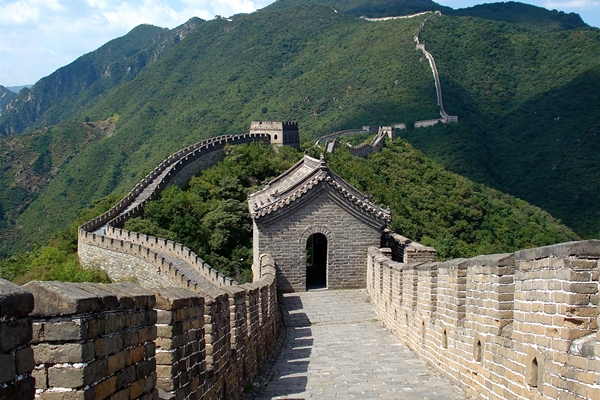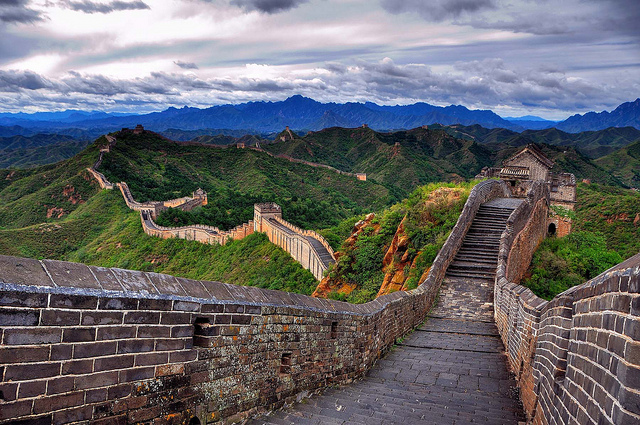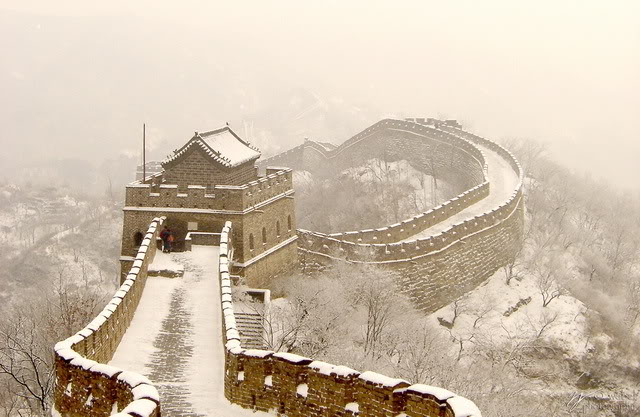ประวัติความเป็นมาของกำแพงเมืองจี เริ่มขึ้นเมื่อป้อมปราการที่สร้างขึ้นโดยรัฐต่างๆในช่วงฤดูใบไม้ผลิและฤดูใบไม้ร่วง(771-476BC) และรบสหรัฐฯ (475-221 BC) ถูกเชื่อมต่อโดยจักรพรรดิแรกของจีนจิ๋นซีฮ่องเต้เพื่อปกป้องเพิ่งก่อตั้งราชวงศ์ฉินของเขา (221-206 BC) รุกรานโดยชนเผ่าเร่ร่อนจากด้านในเอเชีย กำแพงถูกสร้างขึ้นจากดิน สร้างขึ้นโดยการบังคับใช้แรงงานและ212 BCวิ่งจากมณฑลกานซูไปยังชายฝั่งทางตอนใต้ของแมนจูเรีย

ราชวงศ์ต่อมานำมาใช้นโยบายที่แตกต่างกันต่อการป้องกันชายแดนภาคเหนือ ฮั่น (202 ปีก่อนคริสตกาล - 220 AD) ภาคเหนือฉี (550-574) หมี่ (589-618) และโดยเฉพาะอย่างยิ่งหมิง (1369-1644) เป็นหนึ่งในกลุ่มคนที่สร้างขึ้นมาใหม่อีกครั้งบรรจุและขยายกำแพงแม้ว่าพวกเขาจะไม่ค่อยตามเส้นทางของฉิน ฮันขยายปราการห่างไปทางทิศตะวันตกฉีสร้างขึ้นเมื่อประมาณ1,600 กิโลเมตร (990ไมล์) ของผนังใหม่ในขณะที่ของพวกเขาพยายามในการรวมพลกว่าล้านคนในกำแพงโดยกลับกัน ถัง (618-907)เพลง (960-1279), หยวน (1271-1368) และชิง (1644-1911)ส่วนใหญ่ไม่สนับสนุนการสร้างกำแพงชายแดนจึ่งเลือกที่จะแก้ปัญหาอื่นๆ ที่มาจากภายในเอเชีย ภัยคุกคามนี้ เช่น การรณรงค์ทางทหาร และการทูตแทน

แม้ว่าจะเป็นอุปสรรคที่มีประโยชน์กับการตรวจค้นในหลายจุดตลอดประวัติศาสตร์กำแพงล้มเหลวที่จะหยุดศัตรูใน 1644 เมื่อแมนจูเรียชิงข้าผ่านประตูผ่าน Shanhai Pass จึงทำให้ เป็นผู้ปกครองของประเทศจีนกำแพงเมืองจีนที่มองเห็นได้ในวันนี้ส่วนใหญ่จากวันที่ราชวงศ์หมิงที่พวกเขาสร้างขึ้นมาใหม่มากเป็นกำแพงอิฐและหินมักจะขยายสายผ่านภูมิประเทศที่ท้าทาย บางส่วนยังคงอยู่ในสภาพดีหรือไม่ได้รับการปรับปรุงในขณะที่คนอื่นๆได้รับความเสียหายหรือถูกทำลายด้วยเหตุผลอุดมการณ์ชิ้นส่วนสำหรับวัสดุก่อสร้างของพวกเขาหรือสูญเสียไปจากการทำลายล้างของเวลา นานวัตถุของเสน่ห์สำหรับชาวต่างชาติผนังอยู่ในขณะนี้เป็นสัญลักษณ์ประจำชาติที่เคารพนับถือและเป็นสถานที่ท่องเที่ยวที่เป็นที่นิยม

the Great Wall Of China
The history of the Great Wall Of China began whenfortifications built by various states during the Spring and Autumn (771476 bc) and Warring States periods (475221 bc) wereconnected by the first emperor of China, Qin Shi Huang,to protect his newly founded Qin dynasty (221206 bc) againstincursions by nomads from Inner Asia. Thewalls were built of rammed earth, constructed using forced labour, and by 212 bc ranfrom Gansu tothe coast of southern Manchuri.
Later dynasties adopted different policies towards northernfrontier defense. The Han(202 bc 220 ad), the Noethern Qi (550574), the Sui (589618), andparticularly the Ming(13691644) wereamong those that rebuilt, re-manned, and expanded the Walls, although they rarelyfollowed Qin's routes. The Han extended the fortifications furthest to the west,the Qi built about 1,600 kilometers (990 mi) ofnew walls, while the Sui mobilised over a million men in their wall-buildingefforts. Conversely, the Tang (618907), the Song (9601279), the Yuan(12711368), andthe Qing(16441911) mostlydid not build frontier walls, instead opting for other solutions to the InnerAsian threat like military campaigning and diplomacy.
Although a useful deterrent against raids, at several pointsthroughout its history the Great Wall failed to stop enemies, including in 1644when the Manchu Qingmarched through the gates of Shanhai Pass andreplaced the most ardent of the wall-building dynasties, the Ming, as rulersof China.
The Great Wall of China visible today largely dates from theMing dynasty, as they rebuilt much of the wall in stone and brick, oftenextending its line through challenging terrain. Some sections remain in relativelygood condition or have been renovated, while others have been damaged ordestroyed for ideological reasons, deconstructed for their buildingmaterials, or lost due to the ravages of time. Forlong an object of fascination for foreigners, the wall is now a reverednational symbol and a popular tourist destination.




